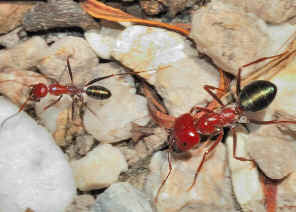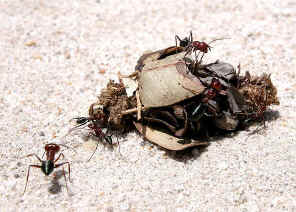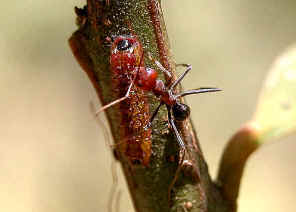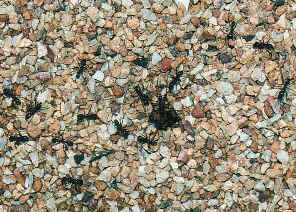Large Purple Meat Ant- Iridomyrmex purpureus
Subfamily Dolichoderinae
This page contains pictures and information about Large Purple Meat Ants that we found in the Brisbane area, Queensland, Australia.

- Body length 8-12mm, attacking a bag caterpillar
- Meat Ants are also known as Mount Ants or Tyrant Ants. Meat Ants are quite the large ants, with long legs and large head. Their abdomen is black in colour with dark red head. Their nest is in soil on ground. They are common in Brisbane bushes.


- Meat Ants are general predators and scavengers. They also tend soft-bug, such as aphids, to collect honeydew. The ants are active the whole year. They are fast running and foraging in large number. Their nests are large and are patrolled by aggressive workers. The Meat Ants are aggressive and they usually dominate the area that they forage. No other species of ants can be seen near by.
-



- The winged class, body length 15mm
- Chris Freebairn sent us email advised that the white scale in the photos "are actually psyllid nymphs, known as lerps. They look like Diaspidid scales (known as hard scales), but this family does not secrete honeydew. Soft scales (Family Coccidae) secrete honeydew and are tended by ants, but look quite different."
- Found quite a number of winged class meat ants outside the nest during mid winter, just after a rainy day.
Attacking a Bag Caterpillar



- Meat Ants are general predators and scavengers. They actively attack the insects that they encountered. In above photos a group og Meat Ants is attacking a bag caterpillar.
Attacking a Cicada



- On Jan 2010 in Karawatha Forest, we saw a Clanger Cicada dropped onto the ground from tree top. It was attached with one Meat Ant. The cicada was buzzing crazily. Within seconds, many Meat Ants came from all directions and attacked the cicada. Within a minute there were a few tens of ants attached to the cicada.
Attending Caterpillar


- On February 2006, we found those Meat Ants attending caterpillars on a wattle tree. We believe the caterpillar could be the Double Spotted Line Blue butterfly caterpillar Nacaduba biocellata.
Attending Lerps Insects
-



- If Meat Ants are found on plants in large number, usually they are attending the psyllid nymphs, known as lerps. They look like Diaspidid scales (known as hard scales), but they does not secrete honeydew.
-



Meat Ants as scavengers
Ant Nest



- Above picture shows Tony examining the Meat Ants nest entrances. Meat Ants nests are built in soil. The above ground structure of nests decorated with small pebbles and having many entrances, which are the single cryptic holes just large enough for individual workers to squeeze through.



- The nest is protected by aggressive workers. The Meat Ants are sensitive to ground vibrations. When we walked closely to within a meter to the nest with heavy foot steps, steam of ants came out and ran straight towards our standing point.
- This is an aggressive ant species. Wherever there is a Meat Ants nest, the ants reduce significantly the number of other ant species from nesting and foraging in the area.
Defending Territory



- In Karawatha Forest, there were a number of nest mounts along the footpath. They were a few tens meters apart. On the intersection we sometimes saw the workers fighting with each others.
- Reference:
- 1. Insects of Australia and New Zealand - R. J. Tillyard, Angus & Robertson, Ltd, Sydney, 1926, p289.
- 2. Iridomyrmex purpurea - Australian Insect Common Names, CSIRO, 2005.
- 3. Iridomyrmex purpureus - Australian Biological Resources Study.
- 4. Nacaduba biocellata - Australian Caterpillar by Don Herbison-Evans & Stella Crossley, 2004.
- 5. Wildlife of Greater Brisbane - New edition, Published by Queensland Museum 2007, p170.
- 6. What wasp is that? - An interactive identification guide to the Australasian families of Hymenoptera, 2007.
- 7. Australian Ants: Their Biology and Identification - S Shattuck, Natalie J Barnett, CSIRO, 1999, p72.


